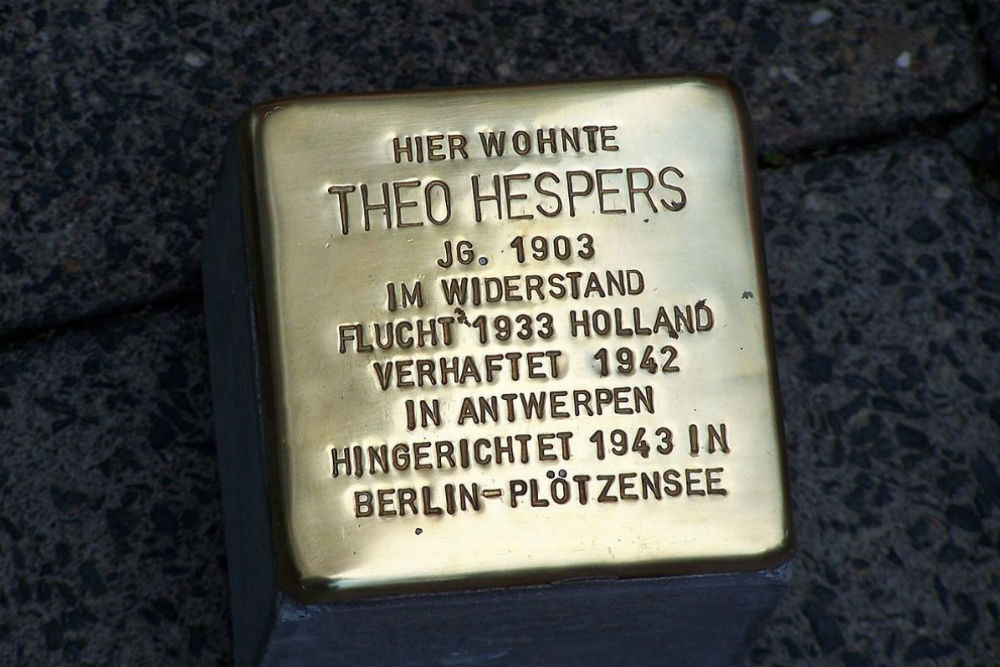Stumbling Stone Am Kämpchen 1
This small, brass memorial plaque (Stolperstein or stumbling stone) commemorates:
* Theo Hespers, born 1903, in the resistance, fled to Holland 1933, arrested 1942 in Antwerp, executed 1943 in Berlin-Plötzensee.
Theo Hespers was born into a strongly Catholic family. At age 14, he joined a Catholic youth movement and stayed with them until 1927 when he was 24. He completed an apprenticeship (1920-23) and a master craftsman course (1923-26) in the textile industry, where he struggled to find regular work.
In 1930, he married Katharina Kelz; they had a son, Dietrich-Franz Hespers, the next year. Theo did not join either of the major political parties but rather stayed with the Christian socialist youth movement. From 1931-1933 he was worked with (but not a member of) the Red Trade Union. He saw the inhumanity of the Nazi ideology and became a candidate for parliament in 1933 representing the Workers and Peasants party.
Under threat of arrest for his actions, Theo Hespers and his family fled to Holland, where they lived on the border with Germany and he smuggled anti-Nazi literature across the border. Under pressure from the German foreign office, the Dutch authorities ordered Theo to leave the border region. He moved with his wife and child to Helmond in North Brabant, where he was the co-editor of a monthly magazine in which young Germans criticized the Nazi regime. Next he co-founded a committee to aid refugees. When the Germans invaded the Netherlands, the Hespers fled to Antwerp. But his non-violent resistance had been taken seriously. There, on 10 February 1942, he and his wife were arrested by the Secret Field Police. Katharina was released, but Theo Hespers was tried and on 22 July 1943 sentenced to death for treason. He was executed on 9 September 1943 in Berlin.
"Stolpersteine" is an art project for Europe by Gunter Demnig to commemorate victims of National Socialism (Nazism). Stolpersteine (stumbling stones) are small, 10x10cm brass plaques placed in the pavement in front of the last voluntary residence of (mostly Jewish) victims who were murdered by the Nazis. Each plaque is engraved with the victim’s name, date of birth, and place (mostly a concentration camp) and date of death. By doing this, Gunter Demnig gives an individual memorial to each victim. One stone, one name, one person. He cites the Talmud: "A human being is forgotten only when his or her name is forgotten."
Do you have more information about this location? Inform us!
Source
- Text: Fedor de Vries & Anne Palmer
- Photos: Klaus-Dieter Machynia
- Stolpersteine in Mönchengladbach: Am Kämpchen 1
- Stolpersteine.eu
Nearby
Point of interest
- Joseph Goebbels Residence - Mönchengladbach - Rheydt
- Birth Haus Paul Joseph Goebbels - Rheydt - Mönchengladbach
- Air Raid Shelter Güdderich - Güdderich-Mönchengladbach
Monument
- War Memorial Mönchengladbach - Mönchengladbach
- Memorial Chapel Mönchengladbach - Mönchengladbach
- Memorial Killed and Missing Soldiers - Mönchengladbach-Wolfsittard
Cemetery
- German War Cemetery Mönchengladbach-Hardt - Mönchengladbach-Hardt
- German War Cemetery Wickrath - Wickrath-Mitte
- German War Graves Mönchengladbach-Hardt - Mönchengladbach-Hardt
Remembrance Stone
- Stumbling Stone Stepgesstraße 29 - Mönchengladbach
- Stumbling Stones Lüpertzender Straße 40 - Mönchengladbach
- Stumbling Stone Bismarckplatz 1 - Mönchengladbach





